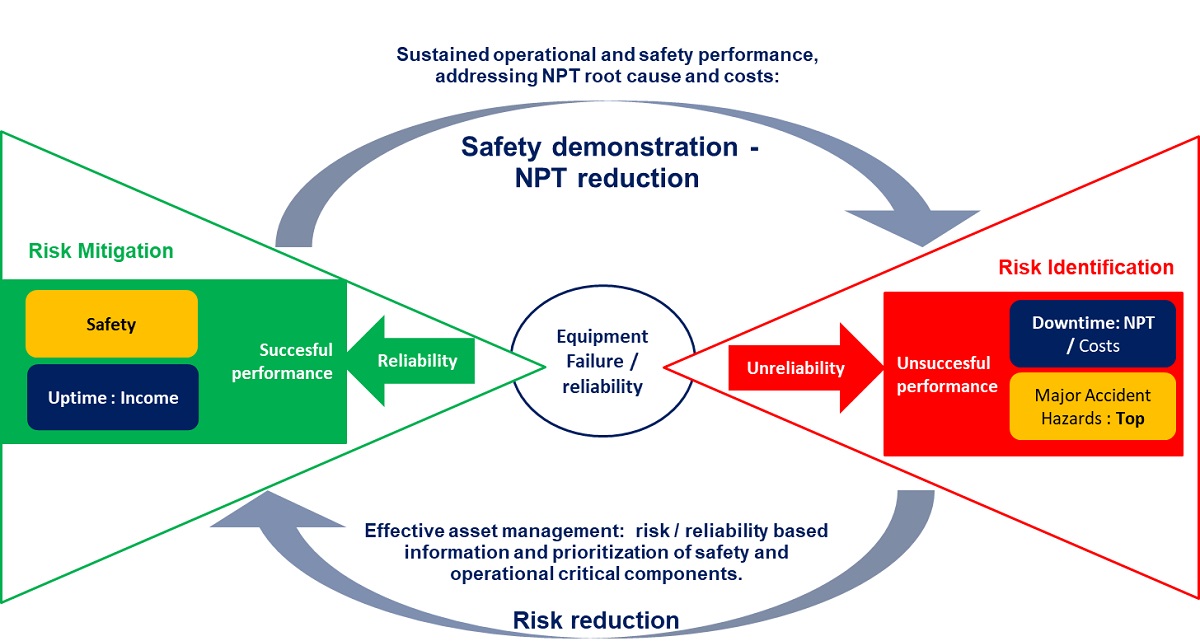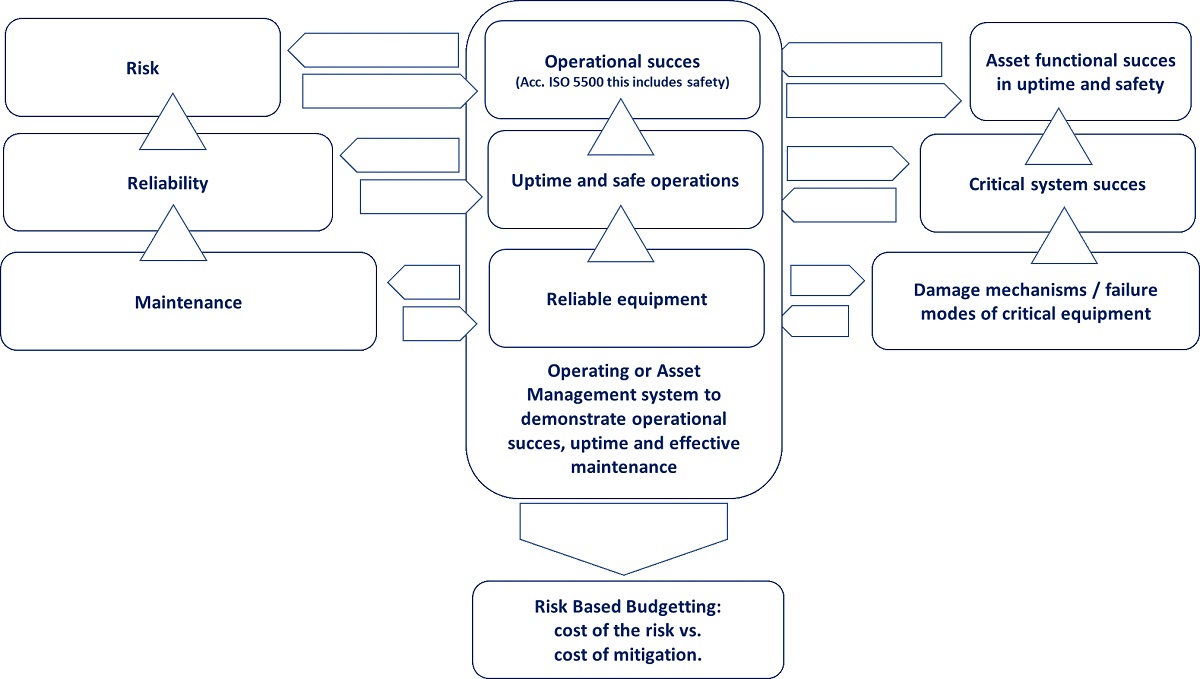For most operations you needs assets, and by using assets you are exposed to risks involved in optimally operating these assets. But what affects the reliability of your operations? One of the key aspects is proper maintenance, but ‘just doing’ maintenance is not really contributing to the prime objective of achieving asset integrity and maximising profitability.
Any risk can be expressed in the Consequence of Failure (CoF) multiplied by the Probability of failure (PoF). For some this looks like child’s math, but I came across multiple companies and people where from this little sum downwards it became already quite fuzzy. Questions like: How do we calculate this or in other words how do we collect the needed data? What is actually needed and at what level? What are the costs involved? are among the first ones to be asked.
Being able to show an asset’s risk and reliability history can provide evidence of what has been done and achieved (this is one of the prime objectives of a good asset management system). The lack of proper asset management often results in the inability to demonstrate compliance in any sense. This aspect cannot be achieved without a proper supporting asset management system.
Risk based budget balance
On top of this all we find operational budget often seen in contradiction to maintenance budget. The outcome may well be that the operations ‘wins’ this, but is it actually winning? On the short term yes, some money was won, but on the risk side … what is the risk worth that was taken by the prevailing operational demand.
Introducing risk-based budget balancing assures that one does not compare apples with pears but that a level playing field is created between operations and ‘maintenance’. They now talk in the same language and use the same figures. Maintaining cost money but prevent risk (through reliability): The trick is to quantify that risk. Not maintaining brings uptime but creates a bigger risk through unreliability. If we can quantify that risk, an aspect is introduced that allows both operations and maintenance to discuss similar equations and units. Besides that cost itself is often seen as a risk-parameter.

One of the two biggest challenges I experience now is lack of proper data to express the risk of asset failure and the lack of insight what the cost of such failure are. Honestly that is not easy, and the impact can be huge. Starting small, manageable, is a among the solutions. Starting with what we understand is a second one. I often see that companies want ‘to do all’ at once and the most complex system at first. This may in itself already be a roadblock in meeting the objectives of proper asset management.
An example from the Oil & Gas industry is the application of ‘safety case regimes’ (officially HSE case) and the demonstration to show compliance of the asset functionality that have a major contribution to the so called Major Accident Hazards or in short MAH’s.
A benefit that I found and used of this approach is that it enables you to reverse-engineer existing maintenance tasks. Just by evaluating them in the way they mitigate risk and increase reliability. An existing maintenance plan does therefore not be fully changed but can be used as a solid baseline: This makes using this process powerful and cost effective.
Structured Approach
The structure behind this can be described as a general roadmap towards risk-based asset management, it cannot be demonstrated without any supporting system and takes safety as well as finance into account. What may be added here is the budget balance, however when it comes to compliance to rules and regulations this plays a lesser role. How does this structured approach look like?
At first the asset is seen as an object to perform a certain function (required to meet company objectives). For every function that’s there to meet any of the plant or asset objectives it can be rated what its contribution is to operational success (safety and sustainability must be regarded as operational success factors). In this set-up a system designed for preventing a safety risk is as much important as a system which sole purpose is to mitigate that same risk or aid in protection when that risk has become apparent. Based on this rating a set of functions with a high criticality towards operational success is listed.

Within these systems we see equipment (assets in themselves) that make that function happen – successful. In some cases, we see redundancy in set-up in other cases it’s just a single equipment. These system parts or equipment whose failure will immediately lead to system and therefore complete functional loss (an immediate threat to one of the main objectives) are the ones that are highly critical (single point failures) and depict system success or not.
Most equipment can fail in several ways expressed by different failure modes or damage mechanisms. We already saw that maintenance based on or related to minimize or control that damage mechanism is most effective meaning it will prevent a lot of risk and create quite some uptime. In other words: By not doing proper maintenance one directly takes responsibility for the risk created. In my experience not many people realize that when they postpone or cancel a maintenance job.
By being able to demonstrate what the risk is (awareness) that will be taken, expressed in cost and balanced against the cost of that risk mitigation provides a more motivated and transparent view on the decisions taken: To maintain or not … that’s the question (that then can be answered more precise).
Decisions on when, why and how maintenance was performed or skipped even before something failed becomes more balanced and much more informed and motivated. This structure allows to make what-if scenarios to set out a balanced choice.
About the Author
I think it is appropriate to make a little introduction of myself to give you as a reader some information on who’s view on risk, reliability and maintenance you’re actually reading.
My name is Pieter, I was born in March 1966 (makes me 52) and I live in IJzendijke, a small rural village in the utmost south-west of the Netherlands. I currently work on making a complete maintenance and spare parts data set for new build frigates of the SIGMA 10514 class build by Damen Schelde Naval Shipbuilding. I studied on Maritime Institute “De Ruyter” and graduated in June 1989 as a Merchant shipping officer. After graduation I quickly discovered that it was impossible to keep the right pace with developments in the fields of maintenance without post-graduate education. That resulted in several training courses, some major some minor but all contributing what I already knew: Risk, Reliability and Maintenance are all part of successful operation no matter in which industry you go.
Based on this I was further encouraged in my believe by what was written in the PAS55 publication in 2004, that later became the ISO55000 standard: Risk Based Asset Management. This standard also introduced that operational success includes the safety aspect. Safety is nowadays one of the major risk factors were previously this may often have been regarded as of a lower importance than i.e. profit.
A quote I often use when advising on the Risk, Reliability and Maintenance process is:
Maintenance is like exercise: One hopes to grow old without doing it. That hope can be made more precise.
Dating back as far as 1987, I discovered the hard way on board the vessel I sailed on that lack of proper maintenance (maintenance that ‘fights’ the proper damage mechanism) can easily lead to ‘ unexpected’ failures and due risk involved. Although in that time I just found it annoying when something failed which meant I had to work 24-7 to get things fixed! The insight and attraction to the aspects of maintenance, reliability and risk and moreover their relation only became fully apparent later, when I had the time to reflect on things and had proper models to provide feed-back to what I experienced.
The experiences I had in my early days support the growth of a strong believe that Risk, Reliability and Maintenance can really be added value to successful operations which aim is to make profit in a safe and sustained way.